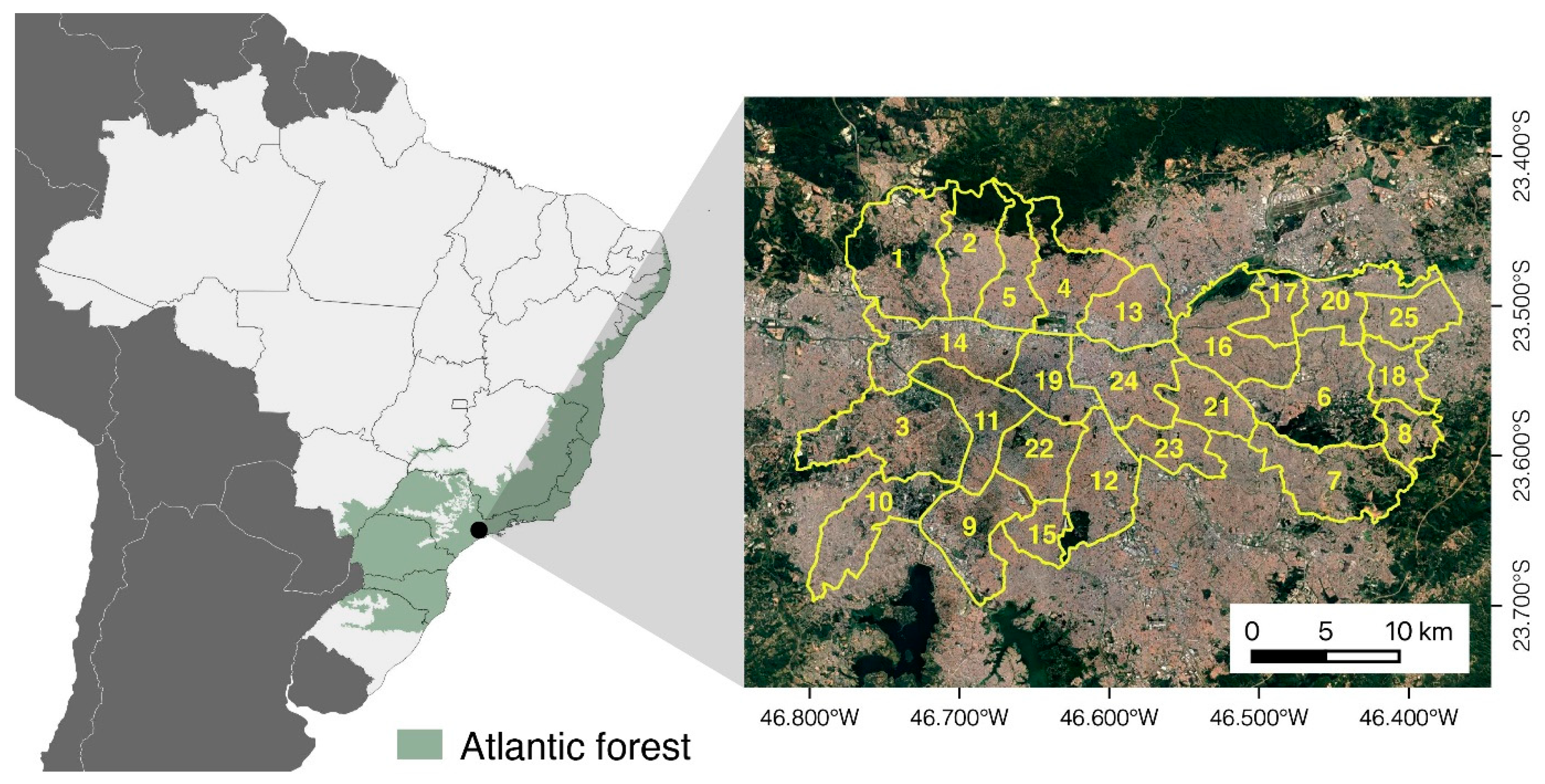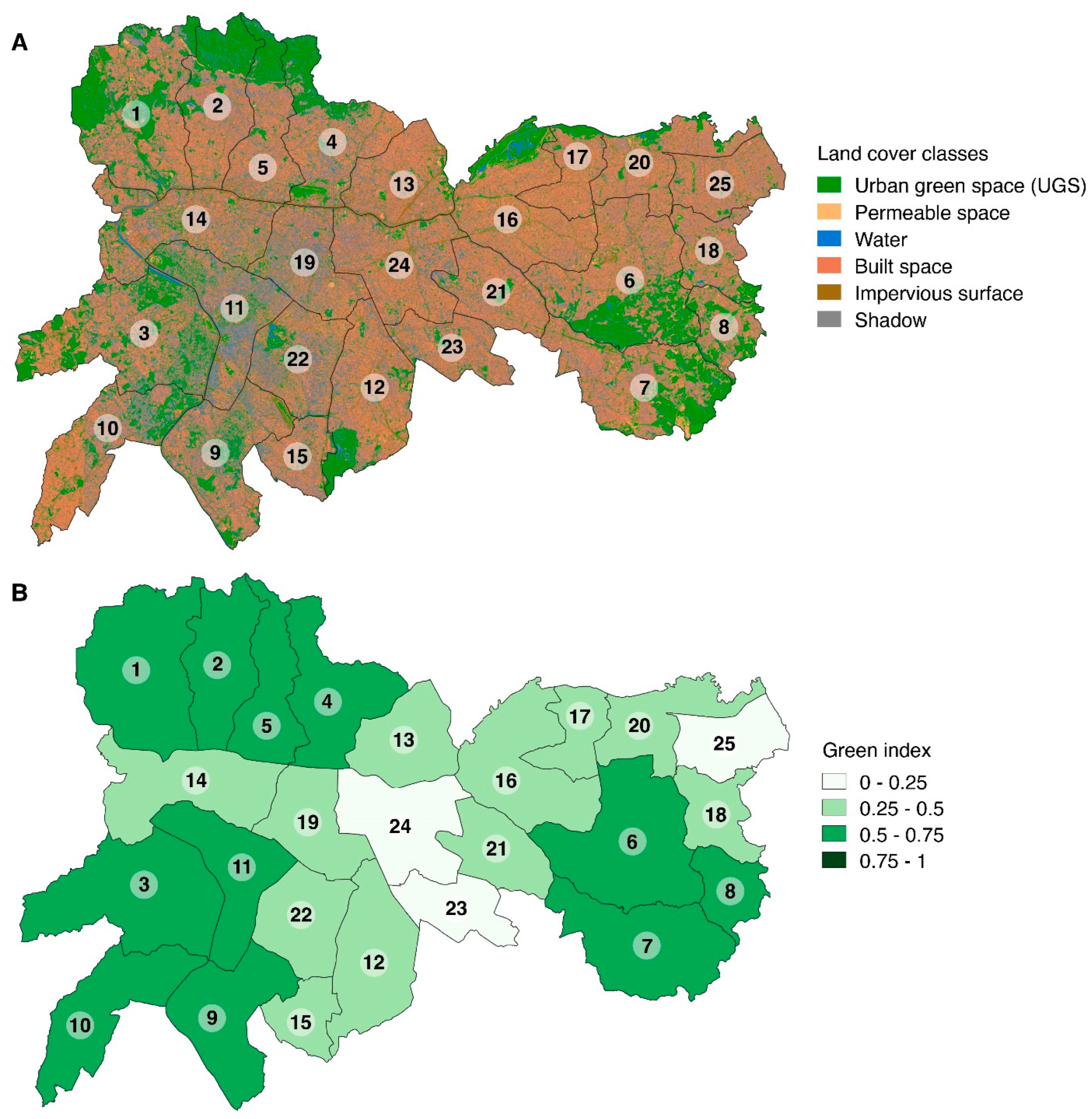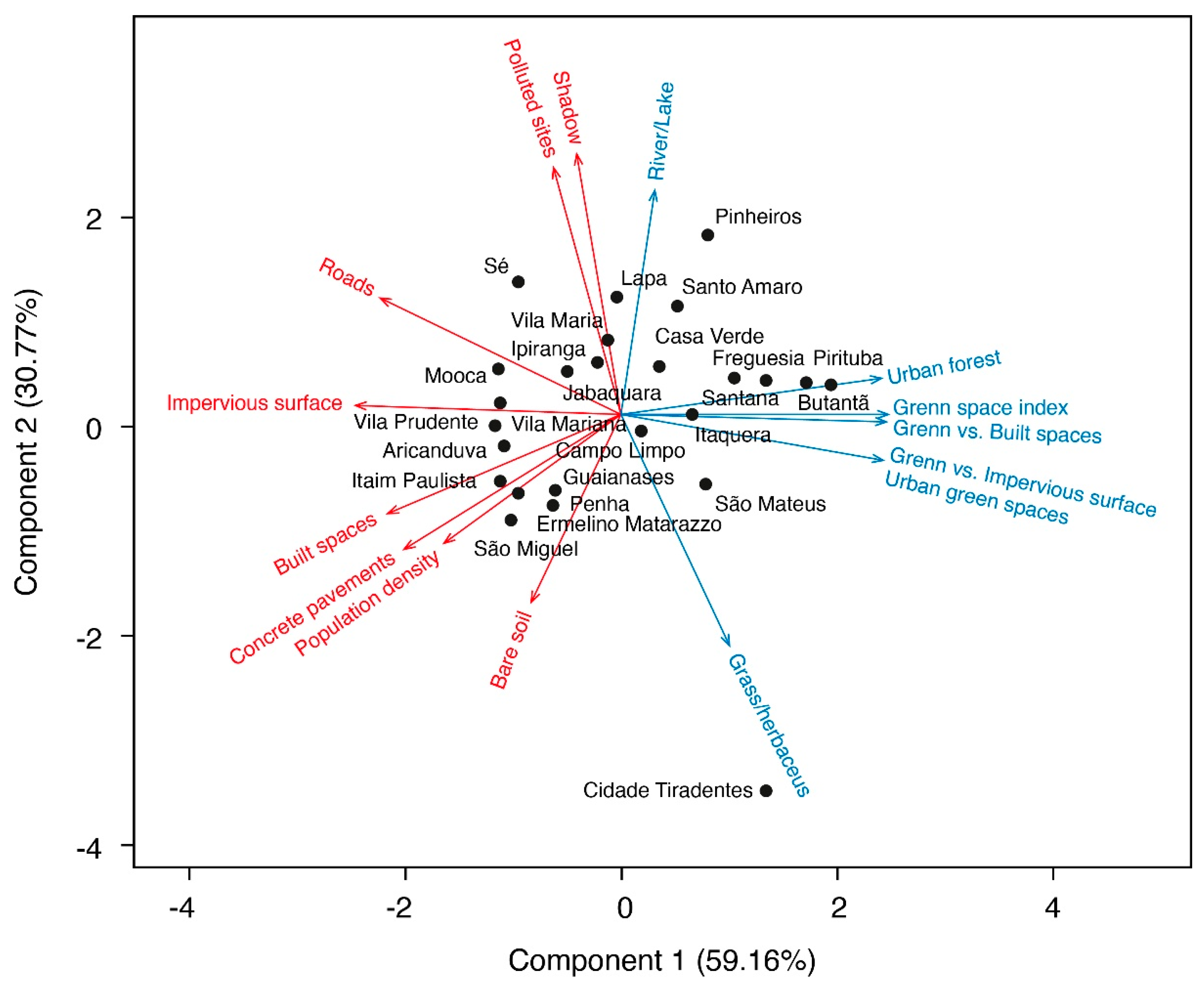Using a Novel Green Index to Support Ecosystem Services in a Megacity
Abstract
:1. Introduction
2. Materials and Methods
2.1. Study Area
2.2. High-Resolution Multispectral Images
2.3. Supervised Classification
2.4. Interaction of Urban Green Spaces and Intra-Urban Elements
3. Results and Discussion
3.1. Supervised Classification
3.2. Interaction of Urban Green Spaces and Intra-Urban Elements
3.3. What Measures Should Be Taken to Improve Urban Spaces? A Warning for Public Managers
4. Conclusions
Supplementary Materials
Author Contributions
Funding
Data Availability Statement
Acknowledgments
Conflicts of Interest
References
- Da Silva Filho, D.F.; Pivetta, K.F.L.; do Couto, H.T.Z.; Polizel, J.L. Indicadores de Floresta Urbana a Partir de Imagens Aéreas Multiespectrais de Alta Resolução. Sci. For. PP-Piracicaba 2005, 88–100. Available online: https://repositorio.unesp.br/handle/11449/68193 (accessed on 1 June 2023).
- Wu, D.; Wang, Y.; Fan, C.; Xia, B. Thermal Environment Effects and Interactions of Reservoirs and Forests as Urban Blue-Green Infrastructures. Ecol. Indic. 2018, 91, 657–663. [Google Scholar] [CrossRef]
- Kondo, M.C.; Fluehr, J.M.; McKeon, T.; Branas, C.C. Urban Green Space and Its Impact on Human Health. Int. J. Environ. Res. Public Health 2018, 15, 445. [Google Scholar] [CrossRef]
- Song, C.; Ikei, H.; Igarashi, M.; Takagaki, M.; Miyazaki, Y. Physiological and Psychological Effects of a Walk in Urban Parks in Fall. Int. J. Environ. Res. Public Health 2015, 12, 14216–14228. [Google Scholar] [CrossRef]
- Chapman, S.; Watson, J.E.M.; Salazar, A.; Thatcher, M.; McAlpine, C.A. The Impact of Urbanization and Climate Change on Urban Temperatures: A Systematic Review. Landsc. Ecol. 2017, 32, 1921–1935. [Google Scholar] [CrossRef]
- Zou, H.; Wang, X. Progress and Gaps in Research on Urban Green Space Morphology: A Review. Sustainability 2021, 13, 1202. [Google Scholar] [CrossRef]
- McPhearson, T.; Andersson, E.; Elmqvist, T.; Frantzeskaki, N. Resilience of and Through Urban Ecosystem Services. Ecosyst. Serv. 2014, 12, 152–156. [Google Scholar] [CrossRef]
- Semeraro, T.; Scarano, A.; Buccolieri, R.; Santino, A.; Aarrevaara, E. Planning of Urban Green Spaces: An Ecological Perspective on Human Benefits. Land 2021, 10, 105. [Google Scholar] [CrossRef]
- Castelli, K.R.; Silva, A.M.; Dunning, J.B. Improving the Biodiversity in Urban Green Spaces: A Nature Based Approach. Ecol. Eng. 2021, 173, 106398. [Google Scholar] [CrossRef]
- Qiu, L.; Liu, F.; Zhang, X.; Gao, T. Difference of Airborne Particulate Matter Concentration in Urban Space with Different Green Coverage Rates in Baoji, China. Int. J. Environ. Res. Public Health 2019, 16, 1465. [Google Scholar] [CrossRef]
- Yu, Z.; Guo, X.; Jørgensen, G.; Vejre, H. How Can Urban Green Spaces Be Planned for Climate Adaptation in Subtropical Cities? Ecol. Indic. 2017, 82, 152–162. [Google Scholar] [CrossRef]
- Baró, F.; Palomo, I.; Zulian, G.; Vizcaino, P.; Haase, D.; Gómez-Baggethun, E. Mapping Ecosystem Service Capacity, Flow and Demand for Landscape and Urban Planning: A Case Study in the Barcelona Metropolitan Region. Land Use Policy 2016, 57, 405–417. [Google Scholar] [CrossRef]
- Daniels, B.; Zaunbrecher, B.S.; Paas, B.; Ottermanns, R.; Ziefle, M.; Roß-Nickoll, M. Assessment of Urban Green Space Structures and Their Quality from a Multidimensional Perspective. Sci. Total Environ. 2018, 615, 1364–1378. [Google Scholar] [CrossRef] [PubMed]
- Nowak, D.J.; Greenfield, E.J. Tree and Impervious Cover Change in U.S. Cities. Urban For. Urban Green. 2012, 11, 21–30. [Google Scholar] [CrossRef]
- Luederitz, C.; Brink, E.; Gralla, F.; Hermelingmeier, V.; Meyer, M.; Niven, L.; Panzer, L.; Partelow, S.; Rau, A.-L.; Sasaki, R.; et al. A Review of Urban Ecosystem Services: Six Key Challenges for Future Research. Ecosyst. Serv. 2015, 14, 98–112. [Google Scholar] [CrossRef]
- Shin, Y.; Kim, S.; Lee, S.-W.; An, K. Identifying the Planning Priorities for Green Infrastructure within Urban Environments Using Analytic Hierarchy Process. Sustainability 2020, 12, 5468. [Google Scholar]
- Shou, Y.; Zhang, D.-L. Recent Advances in Understanding Urban Heat Island Effects with Some Future Prospects. J. Meteorol. Res. 2012, 70, 338–353. [Google Scholar]
- Azmy, M.M.; Hosaka, T.; Numata, S. Responses of Four Hornet Species to Levels of Urban Greenness in Nagoya City, Japan: Implications for Ecosystem Disservices of Urban Green Spaces. Urban For. Urban Green. 2016, 18, 117–125. [Google Scholar] [CrossRef]
- GAO, J.; SONG, T.; ZHANG, B.; HAN, Y.; GAO, X.; FENG, C. The Relationship between Urban Green Space Community Structure and Air Temperature Reduction and Humidity Increase in Beijing. Resour. Sci. 2016, 38, 1028–1038. [Google Scholar] [CrossRef]
- Liu, F.; Yan, W.; Kong, F.; Yin, H.; Ban, Y.; Xu, W. A Review on the Urban Green Space Cooling Effect Based on Field Measurement of Air Temperature. Chinese J. Appl. Ecol. 2017, 28, 1387–1396. [Google Scholar] [CrossRef]
- Liu, Y.; Li, H.; Li, C.; Zhong, C.; Chen, X. An Investigation on Shenzhen Urban Green Space Changes and Their Effect on Local Eco-Environment in Recent Decades. Sustainability 2021, 13, 12549. [Google Scholar] [CrossRef]
- Abutaleb, K.; Freddy Mudede, M.; Nkongolo, N.; Newete, S.W. Estimating Urban Greenness Index Using Remote Sensing Data: A Case Study of an Affluent vs Poor Suburbs in the City of Johannesburg. Egypt. J. Remote Sens. Space Sci. 2021, 24, 343–351. [Google Scholar] [CrossRef]
- Shahtahmassebi, A.R.; Li, C.; Fan, Y.; Wu, Y.; Lin, Y.; Gan, M.; Wang, K.; Malik, A.; Blackburn, G.A. Remote Sensing of Urban Green Spaces: A Review. Urban For. Urban Green. 2021, 57, 126946. [Google Scholar] [CrossRef]
- Gupta, K.; Kumar, P.; Pathan, S.K.; Sharma, K.P. Urban Neighborhood Green Index—A measure of green spaces in urban areas. Landsc. Urban Plan. 2012, 105, 325–335. [Google Scholar] [CrossRef]
- IBGE. Instituto Brasileiro de Geografia e Estatística. São Paulo. Available online: https://cidades.ibge.gov.br/brasil/sp/sao-paulo/panorama (accessed on 1 June 2023).
- Alvares, C.A.; Stape, J.L.; Sentelhas, P.C.; de Moraes Gonçalves, J.L.; Sparovek, G. Köppen’s Climate Classification Map for Brazil. Meteorol. Zeitschrift 2014, 22, 711–728. [Google Scholar] [CrossRef]
- Karasiak, N. Dzetsaka Qgis Classification Plugin; 2016. [Google Scholar]
- Landis, J.R.; Koch, G.G. A One-Way Components of Variance Model for Categorical Data. Biometrics 1977, 33, 671. [Google Scholar] [CrossRef]
- Rwanga, S.S.; Ndambuki, J.M. Accuracy Assessment of Land Use/Land Cover Classification Using Remote Sensing and GIS. Int. J. Geosci. 2017, 8, 611–622. [Google Scholar] [CrossRef]
- Natteshan, N.V.S.; Kumar, N. Effective SAR Image Segmentation and Classification of Crop Areas Using MRG and CDNN Techniques. Eur. J. Remote Sens. 2020, 53, 126–140. [Google Scholar] [CrossRef]
- Bhosle, K.; Musande, V. Evaluation of Deep Learning CNN Model for Land Use Land Cover Classification and Crop Iden-tification Using Hyperspectral Remote Sensing Images. J. Indian Soc. Remote. Sens. 2019, 47, 1949–1958. [Google Scholar] [CrossRef]
- Kussul, N.; Lavreniuk, M.; Skakun, S.; Shelestov, A. Deep Learning Classification of Land Cover and Crop Types Using Remote Sensing Data. IEEE Geosci. Remote Sens. Lett. 2017, 14, 778–782. [Google Scholar] [CrossRef]
- Kaur, P.; Kale, K. Deep Convolutional Neural Network Models for Land Use and Land Cover Identification Using Dataset Created from LISS-IV Satellite ImagesInt. J. Sci. Res. Comput. Sci. Eng. Inf. Technol. 2018, 3, 2123–2134. [Google Scholar]
- Yuan, Q.; Shen, H.; Li, T.; Li, Z.; Li, S.; Jiang, Y.; Xu, H.; Tan, W.; Yang, Q.; Wang, J.; et al. Deep Learning in Environmental Remote Sensing: Achievements and Challenges. Remote Sens. Environ. 2020, 241, 111716. [Google Scholar] [CrossRef]
- Arantes, B.L.; Castro, N.R.; Gilio, L.; Polizel, J.L.; Silva Filho, D.F. da Urban Forest and per Capita Income in the Mega-City of Sao Paulo, Brazil: A Spatial Pattern Analysis. Cities 2021, 111, 103099. [Google Scholar] [CrossRef]
- Lombardo, M.A. Ilha de Calor Nas Metrópoles: O Exemplo de São Paulo; Geografia, T.e.R., de Lalekla, S.A., Eds.; Hucitec Editora Comércio e Indústria: São Paulo, Brazil, 1985; 244p. [Google Scholar]
- de Groot, R.; Brander, L.; van der Ploeg, S.; Costanza, R.; Bernard, F.; Braat, L.; Christie, M.; Crossman, N.; Ghermandi, A.; Hein, L.; et al. Global Estimates of the Value of Ecosystems and Their Services in Monetary Units. Ecosyst. Serv. 2012, 1, 50–61. [Google Scholar] [CrossRef]
- Lino, J.d.S.; Aquino, A.R.d. A Study of Contaminated Land in São Paulo City, Brazil and Mainly Adopted Remediation Process Face a Deficient Database. Int. J. Environ. Pollut. Remediat. 2019, 7, 23–35. [Google Scholar] [CrossRef]
- Dennis, L. Annual Update: Top Governmental and Not-for-Profit Accounting and Auditing Issues Facing CPAs; John Wiley & Sons: Hoboken, NJ, USA, 2020. [Google Scholar] [CrossRef]
- Nowak, D.J.; Hirabayashi, S.; Doyle, M.; McGovern, M.; Pasher, J. Air Pollution Removal by Urban Forests in Canada and Its Effect on Air Quality and Human Health. Urban For. Urban Green. 2018, 29, 40–48. [Google Scholar] [CrossRef]
- Jim, C.Y.; Chen, W.Y. Ecosystem Services and Valuation of Urban Forests in China. Cities 2009, 26, 187–194. [Google Scholar] [CrossRef]
- Bolund, P.; Hunhammar, S. Ecosystem Services in Urban Areas. Ecol. Econ. 1999, 29, 293–301. [Google Scholar] [CrossRef]
- Streiling, S.; Matzarakis, A. Influence of Single and Small Clusters of Trees on the Bioclimate of a City: A Case Study. J. Arboric. 2003, 29, 309–316. [Google Scholar]
- Haddad, E.A.; Teixeira, E. Economic Impacts of Natural Disasters in Megacities: The Case of Floods in São Paulo, Brazil. Habitat Int. 2015, 45, 106–113. [Google Scholar] [CrossRef]
- Xu, Z.; Xu, J.; Yin, H.; Jin, W.; Li, H.; He, Z. Urban River Pollution Control in Developing Countries. Nat. Sustain. 2019, 2, 158–160. [Google Scholar] [CrossRef]
- Adas, M.A.A.; Hardt, E.; Miraglia, S.G.e.K.; Semensatto, D. Reforest or Perish: Ecosystem Services Provided by Riparian Vegetation to Improve Water Quality in an Urban Reservoir (São Paulo, Brazil). Sustentabilidade Em Debate 2020, 11, 226–243. [Google Scholar] [CrossRef]
- McPherson, E.G.; Simpson, J.R.; Xiao, Q.; Wu, C. Million Trees Los Angeles Canopy Cover and Benefit Assessment. Landsc. Urban Plan. 2011, 99, 40–50. [Google Scholar] [CrossRef]
- Soares, A.L.; Rego, F.C.; McPherson, E.G.; Simpson, J.R.; Peper, P.J.; Xiao, Q. Benefits and Costs of Street Trees in Lisbon, Portugal. Urban For. Urban Green. 2011, 10, 69–78. [Google Scholar] [CrossRef]
- Siriwardena, S.; Boyle, K.; Holmes, T.; Wiseman, P. The Implicit Value of Tree Cover in the U.S.: A Meta-Analysis of Hedonic Property Value Studies. Ecol. Econ. 2016, 128, 68–76. [Google Scholar] [CrossRef]
- Jennings, V.; Bamkole, O. The Relationship between Social Cohesion and Urban Green Space: An Avenue for Health Promotion. Int. J. Environ. Res. Public Health 2019, 16, 452. [Google Scholar] [CrossRef]
- Hansen, R.; Olafsson, A.S.; van der Jagt, A.P.N.; Rall, E.; Pauleit, S. Planning Multifunctional Green Infrastructure for Compact Cities: What Is the State of Practice? Ecol. Indic. 2019, 96, 99–110. [Google Scholar] [CrossRef]
- Mitchell, R.; Popham, F. Effect of Exposure to Natural Environment on Health Inequalities: An Observational Population Study. Lancet 2008, 372, 1655–1660. [Google Scholar] [CrossRef] [PubMed]
- Ghahramani, M.; Galle, N.J.; Ratti, C.; Pilla, F. Tales of a City: Sentiment Analysis of Urban Green Space in Dublin. Cities 2021, 119, 103395. [Google Scholar] [CrossRef]
- Liu, L.; Qu, H.; Ma, Y.; Wang, K.; Qu, H. Restorative Benefits of Urban Green Space: Physiological, Psychological Restoration and Eye Movement Analysis. J. Environ. Manag. 2022, 301, 113930. [Google Scholar] [CrossRef]
- Endreny, T.A. Strategically Growing the Urban Forest Will Improve Our World. Nat. Commun. 2018, 9, 1160. [Google Scholar] [CrossRef] [PubMed]
- Endreny, T.; Santagata, R.; Perna, A.; Stefano, C.D.; Rallo, R.F.; Ulgiati, S. Implementing and Managing Urban Forests: A Much Needed Conservation Strategy to Increase Ecosystem Services and Urban Wellbeing. Ecol. Modell. 2017, 360, 328–335. [Google Scholar] [CrossRef]
- São Paulo. Lei No 16.050, de 31 de Julho de 2014. Política de Desenvolvimento Urbano e o Plano Diretor Estratégico Do Município de São Paulo; 2014.
- United Nations Sustainable Development Goals. Available online: https://sdgs.un.org/goals (accessed on 26 September 2022).
- Guidi Nissim, W.; Labrecque, M. Reclamation of Urban Brownfields through Phytoremediation: Implications for Building Sustainable and Resilient Towns. Urban For. Urban Green. 2021, 65, 127364. [Google Scholar] [CrossRef]
- Ucella-Filho, J.G.M.; Lucas, F.M.F.; Almeida, D.M.; Silva, B.R.F.; Almeida, D.M.; Brito, D.Y.O.; Azevêdo, T.K.B. Biodiverse Neighborhoods: An Ex-Situ Conservation Tool. Ornam. Hortic. 2022, 28, 8–18. [Google Scholar] [CrossRef]
- Zhang, Z.; Meerow, S.; Newell, J.P.; Lindquist, M. Enhancing Landscape Connectivity through Multifunctional Green Infrastructure Corridor Modeling and Design. Urban For. Urban Green. 2019, 38, 305–317. [Google Scholar] [CrossRef]
- Cabe, S. Paying for Parks: Eight Models for Funding Urban Green Space; Commission for Architecture and the Built Environment: London, UK, 2006; 6p. [Google Scholar]





| Kappa Statistics | Strength of Agreement |
|---|---|
| <0.00 | Poor |
| 0.00–0.20 | Slight |
| 0.21–0.40 | Fair |
| 0.41–0.60 | Moderate |
| 0.61–0.80 | Substantial |
| 0.81–1.00 | Almost perfect |
| Green Index | Range of Values |
|---|---|
| Low green quality | <0.25 |
| Moderate green quality | 0.25–0.5 |
| High green quality | 0.5–0.75 |
| Very high green quality | 0.75–1 |
| Regional Prefecture | Reg. | Map Legend 1 | Urban Forest | Green Spaces | Built Spaces | Imper. Surfaces | Pop. Density | GIP 2 | GBP 3 | Green Index | Green Quality |
|---|---|---|---|---|---|---|---|---|---|---|---|
| Pirituba | North | 1 | 37.7 | 42.5 | 20.2 | 16.7 | 8407.2 | 0.72 | 0.68 | 0.70 | High |
| Butantã | West | 3 | 33.2 | 38.6 | 21.8 | 15.3 | 8072.8 | 0.72 | 0.64 | 0.68 | High |
| Freguesia | North | 2 | 34.6 | 36.9 | 20.4 | 21.4 | 12,926.9 | 0.63 | 0.64 | 0.64 | High |
| Santana | North | 4 | 31.2 | 35.1 | 20.7 | 19.3 | 9111.0 | 0.65 | 0.63 | 0.64 | High |
| Cidade Tiradentes | East | 8 | 24.1 | 37.2 | 23.9 | 19.2 | 14,658.0 | 0.66 | 0.61 | 0.63 | High |
| São Mateus | East | 7 | 24.1 | 34.9 | 25.4 | 19.7 | 9773.5 | 0.64 | 0.58 | 0.61 | High |
| Itaquera | East | 6 | 26.9 | 34.1 | 24.6 | 23.0 | 9827.2 | 0.60 | 0.58 | 0.59 | High |
| Casa Verde | North | 5 | 27.2 | 29.5 | 23.0 | 24.4 | 11,235.5 | 0.55 | 0.56 | 0.55 | High |
| Santo Amaro | South | 9 | 23.4 | 27.6 | 23.7 | 21.6 | 6540.9 | 0.56 | 0.54 | 0.55 | High |
| Pinheiros | West | 11 | 20.8 | 24.0 | 20.1 | 20.7 | 9274.2 | 0.54 | 0.54 | 0.54 | High |
| Campo Limpo | South | 10 | 22.1 | 26.4 | 28.9 | 21.8 | 18,296.2 | 0.55 | 0.48 | 0.51 | High |
| Ipiranga | South | 12 | 18.7 | 21.8 | 26.4 | 28.1 | 12,656.5 | 0.44 | 0.45 | 0.45 | Moderate |
| Vila Maria | North | 13 | 15.0 | 17.6 | 23.3 | 25.3 | 10,888.5 | 0.41 | 0.43 | 0.42 | Moderate |
| Lapa | West | 14 | 14.6 | 18.3 | 25.6 | 28.3 | 8049.0 | 0.39 | 0.42 | 0.41 | Moderate |
| Penha | East | 16 | 11.3 | 19.7 | 28.0 | 30.9 | 10,821.5 | 0.39 | 0.41 | 0.40 | Moderate |
| Guaianases | East | 18 | 10.7 | 19.6 | 31.3 | 29.6 | 15,151.9 | 0.40 | 0.38 | 0.39 | Moderate |
| Jabaquara | South | 15 | 13.6 | 16.1 | 28.7 | 26.9 | 15,920.2 | 0.37 | 0.36 | 0.37 | Moderate |
| São Miguel | East | 20 | 8.5 | 15.2 | 31.8 | 33.8 | 14,645.5 | 0.31 | 0.32 | 0.32 | Moderate |
| Ermelino Matarazzo | East | 17 | 11.0 | 15.3 | 32.4 | 34.2 | 13,542.1 | 0.31 | 0.32 | 0.31 | Moderate |
| Sé | Central | 19 | 8.9 | 10.9 | 22.5 | 33.8 | 17,537.3 | 0.24 | 0.33 | 0.29 | Moderate |
| Aricanduva | East | 21 | 8.2 | 11.8 | 29.7 | 33.0 | 12,199.9 | 0.26 | 0.29 | 0.27 | Moderate |
| Vila Mariana | South | 22 | 8.1 | 11.3 | 28.6 | 36.6 | 13,468.4 | 0.24 | 0.28 | 0.26 | Moderate |
| Vila Prudente | East | 23 | 7.9 | 10.6 | 29.4 | 34.6 | 12,320.5 | 0.23 | 0.27 | 0.25 | Moderate |
| Mooca | East | 24 | 7.3 | 9.8 | 27.0 | 35.2 | 10,222.8 | 0.22 | 0.27 | 0.24 | Low |
| Itaim Paulista | East | 25 | 6.2 | 10.6 | 34.3 | 36.3 | 17,186.0 | 0.23 | 0.24 | 0.23 | Low |
Disclaimer/Publisher’s Note: The statements, opinions and data contained in all publications are solely those of the individual author(s) and contributor(s) and not of MDPI and/or the editor(s). MDPI and/or the editor(s) disclaim responsibility for any injury to people or property resulting from any ideas, methods, instructions or products referred to in the content. |
© 2023 by the authors. Licensee MDPI, Basel, Switzerland. This article is an open access article distributed under the terms and conditions of the Creative Commons Attribution (CC BY) license (https://creativecommons.org/licenses/by/4.0/).
Share and Cite
Sant’Anna Neto, A.; Lana, A.Q.; Lucas, F.M.F.; Ucella-Filho, J.G.M.; Polizel, J.L.; da Silva Filho, D.F.; Gonçalves, A.N.; Dias Júnior, A.F. Using a Novel Green Index to Support Ecosystem Services in a Megacity. Forests 2023, 14, 1705. https://doi.org/10.3390/f14091705
Sant’Anna Neto A, Lana AQ, Lucas FMF, Ucella-Filho JGM, Polizel JL, da Silva Filho DF, Gonçalves AN, Dias Júnior AF. Using a Novel Green Index to Support Ecosystem Services in a Megacity. Forests. 2023; 14(9):1705. https://doi.org/10.3390/f14091705
Chicago/Turabian StyleSant’Anna Neto, Analder, Artur Queiroz Lana, Fernanda Moura Fonseca Lucas, João Gilberto Meza Ucella-Filho, Jefferson Lordello Polizel, Demóstenes Ferreira da Silva Filho, Antonio Natal Gonçalves, and Ananias Francisco Dias Júnior. 2023. "Using a Novel Green Index to Support Ecosystem Services in a Megacity" Forests 14, no. 9: 1705. https://doi.org/10.3390/f14091705






